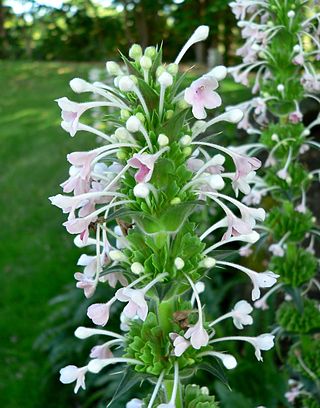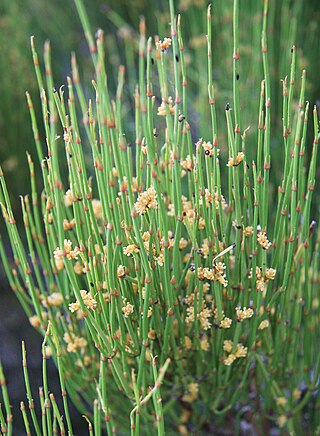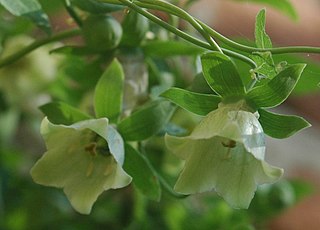
The Himalayas, or Himalaya is a mountain range in Asia, separating the plains of the Indian subcontinent from the Tibetan Plateau. The range has several peaks exceeding an elevation of 8,000 m (26,000 ft) including Mount Everest, the highest mountain on Earth. The mountain range runs for 2,400 km (1,500 mi) as an arc from west-northwest to east-southeast at the northern end of the Indian subcontinent.

Saccharum is a genus of tall perennial plants of the broomsedge tribe within the grass family.

Abutilon is a large genus of flowering plants in the mallow family, Malvaceae. It is distributed throughout the tropics and subtropics of the Americas, Africa, Asia, and Australia. General common names include Indian mallow and velvetleaf; ornamental varieties may be known as room maple, parlor maple, or flowering maple. The genus name is an 18th-century Neo-Latin word that came from the Arabic ’abū-ṭīlūn, the name given by Avicenna to this or a similar genus.

Morina is a genus flowering plants in the family Caprifoliaceae. It includes 14 species native to Eurasia, ranging from southeastern Europe through Western and Central Asia to the Himalayas, China, Bangladesh, and Myanmar. It is named in honor of Louis Morin de Saint-Victor (1635–1715), a French physician, botanist and meteorologist.

Olea is a genus of flowering plants in the family Oleaceae. It includes 12 species native to warm temperate and tropical regions of the Middle East, southern Europe, Africa, southern Asia, and Australasia. They are evergreen trees and shrubs, with small, opposite, entire leaves. The fruit is a drupe. Leaves of Olea contain trichosclereids.

Najas, the water-nymphs or naiads, is a genus of aquatic plants. It is cosmopolitan in distribution, first described for modern science by Linnaeus in 1753. Until 1997, it was rarely placed in the Hydrocharitaceae, and was often taken as constituting the family Najadaceae.

Ephedra is a genus of gymnosperm shrubs. The various species of Ephedra are widespread in many arid regions of the world, ranging across southwestern North America, southern Europe, northern Africa, southwest and central Asia, northern China, and western South America. It is the only extant genus in its family, Ephedraceae, and order, Ephedrales, and one of the three living members of the division Gnetophyta alongside Gnetum and Welwitschia.

Codonopsis is a genus of flowering plant in the family Campanulaceae. As currently recognized, Codonopsis includes two other groups sometimes separated as distinct genera, i.e. Campanumoea and Leptocodon. The enlarged genus Codonopsis is widespread across eastern, southern, central, and southeastern Asia, including China, Japan, the Russian Far East, Kazakhstan, the Indian Subcontinent, Iran, Indochina, Indonesia, etc.

Franz Xaver Freiherr von Wulfen was an Austrian botanist, zoologist, mineralogist, alpinist, and Jesuit priest. He is credited with discovering the flowering plants Wulfenia carinthiaca, Saxifraga moschata, and Stellaria bulbosa. In 1845 the lead molybdate mineral wulfenite was named in his honor by Wilhelm Karl von Haidinger.

Neottia is a genus of orchids. The genus now includes the former genus Listera, commonly known as twayblades referring to the single pair of opposite leaves at the base of the flowering stem. The genus is native to temperate, subarctic and arctic regions across most of Europe, northern Asia, and North America, with a few species extending into subtropical regions in the Mediterranean, Indochina, the southeastern United States, etc.

Wulfenia is a plant genus in the family Plantaginaceae. The genus was named after Franz Xaver von Wulfen (1728–1805), an Austrian botanist, zoologist, mineralogist, alpinist, and Jesuit priest. It was first described in 1781 by Nikolaus Joseph von Jacquin in. It is also in Tribe Veroniceae.

Veronicastrum is a genus of flowering plants in the family Plantaginaceae. In some taxonomy systems, Veronicastrum species have been placed within the genus Veronica. The most commonly cultivated species is Veronicastrum virginicum, which is native to the Eastern parts of North America. Veronicastrum has previously been part of the family Scrophulariaceae. However, following recent genetic studies, several genera were transferred to other families including Veronicastrum, transferred to Plantaginaceae.

Uraria is a genus of plants in the legume family, Fabaceae. It includes 24 species of shrubs and subshrubs native to sub-Saharan Africa, the Indian Subcontinent, Indochina, China, Malesia, Papuasia, Australia, and the South Pacific. Typical habitats are seasonally-dry tropical woodland or grassland. It belongs to the subfamily Faboideae and the tribe Desmodieae.

Schizachyrium is a widespread genus of plants in the grass family. The name is derived from the Ancient Greek words σχίζειν, meaning "to split," and ἄχυρον, meaning "chaff." It refers to either the glume or the toothed lemmas.

Murdannia is a genus of annual or perennial monocotyledonous flowering plants in the family Commelinaceae.

Vicoa is a genus of flowering plants belonging to elecampane tribe within the Asteraceae. It is found in parts of Africa and stretching across Asia to Indochina. It was described by Alexandre Henri Gabriel de Cassini (Cass.) in 1829, but the genus was later absorbed into the Pentanema genus. Until molecular analysis in 2018, determined it was a separate genus.

The taxonomy of Tulipa places the genus in the family Liliaceae, and subdivides it as four subgenera, and comprises about 75 species.

Paederota bonarota is a species of flowering plant in the family Plantaginaceae. It is a perennial native to the eastern Alps of Italy, Austria, and Slovenia, where it grows only on dolomite.
Wulfeniopsis is a genus of flowering plants belonging to the family Plantaginaceae. It is also in Tribe Veroniceae.

Rosa webbiana, occasionally called Webb's rose, wild rose, or thorny rose, is a widely distributed species of flowering plant in the family Rosaceae. It is native to Central Asia, Tibet and Xinjiang in China, Afghanistan, Pakistan, the western Himalayas, and Nepal. It grows in scrub, grassy places, valleys, and slopes. A diploid, its chromosome count is 2n = 2x = 14.


















